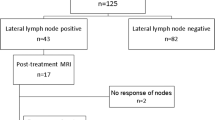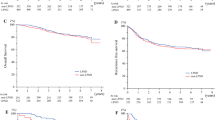Abstract
Background
Few reports have evaluated the long-term outcomes of pathological T1 (pT1) lower rectal cancer (LRC), perhaps because pT1 LRC is classified as TNM stage I if lymph node metastasis (LNM) is absent and stage IIIA if LNM is present. Moreover, it is difficult to diagnose regional LNM preoperatively. This study aimed to clarify the long-term outcomes of radical surgery for pT1 LRC and risk factor(s) for LNM. Additionally, we examined whether preoperative computed tomography (CT) and magnetic resonance imaging (MRI) findings were predictive of LNM in pT1 LRC.
Methods
This was a retrospective analysis of the clinical characteristics, short-term operative outcomes, and long-term survival rates of 155 patients who received radical surgery and were diagnosed with pT1 LRC at our hospital between January 1993 and February 2017.
Results
Among patients with pT1 LRC, 5-year recurrence-free and overall survival rates were 94.0% and 95.8%, respectively. LNM status was not associated with statistically significant differences in recurrence-free or overall survival. Even in patients with LNM, the recurrence rate was only 9%. Among patients who lacked visible mesorectal lymph nodes on preoperative CT and MRI, LNM rates were 3.5% and 4.3%, respectively.
Conclusion
The long-term outcomes after radical surgery for pT1 LRC are satisfactory or good, regardless of the presence or absence of LNM. In patients with pT1 LRC, the absence of visible mesorectal lymph nodes on preoperative CT and MRI is associated with a reduced likelihood of LNM and has a high negative predictive value for LNM.


Similar content being viewed by others
References
Matsuda T, Fujii T, Saito Y et al (2008) Efficacy of the invasive/non-invasive pattern by magnifying chromoendoscopy to estimate the depth of invasion of early colorectal neoplasms. Am J Gastroenterol 103:2700–2706
National Comprehensive Cancer Network. Rectal cancer. http://www.nccn.org/professionals/physician_gls/pdf/rectal.pdf. Accessed 13 April 2015
Filippone A, Ambrosini R, Fuschi M et al (2004) Preoperative T and N staging of colorectal cancer: accuracy of contrast-enhanced multi-detector row CT colonography—initial experience. Radiology 231(1):83–90
Kunawudhi A, Sereeborwornthanasak K, Promteangtrong C et al (2016) Value of FDG PET/contrast-enhanced CT in initial staging of colorectal cancer—comparison with contrast-enhanced CT. Asian Pac J Cancer Prev 17(8):4071–4075
Dighe S, Purkayastha S, Swift I et al (2010) Diagnostic precision of CT in local staging of colon cancers: a meta-analysis. Clin Radiol 65(9):708–719
Al-Sukhni E, Milot L, Fruitman M et al (2012) Diagnostic accuracy of MRI for assessment of T category, lymph node metastases, and circumferential resection margin involvement in patients with rectal cancer: a systematic review and meta-analysis. Ann Surg Oncol 19(7):2212–2223
Akasu T, Iinuma G, Takawa M et al (2009) Accuracy of high-resolution magnetic resonance imaging in preoperative staging of rectal cancer. Ann Surg Oncol 16(10):2787–2794
Hager T, Gall FP, Hermanek P (1983) Local excision of cancer of the rectum. Dis Colon Rectum 26:149–151
Stearns MW Jr, Sternberg SS, DeCosse JJ (1984) Treatment alternatives: localized rectal cancer. Cancer 54(11 suppl):2691–2694
Whiteway J, Nicholls RJ, Morson BC (1985) The role of surgical local excision in the treatment of rectal cancer. Br J Surg 72:694–697
Biggers OR, Beart RW Jr, Ilstrup DM (1986) Local excision of rectal cancer. Dis Colon Rectum 29:374–377
Billingham RP (1992) Conservative treatment of rectal cancer: extending the indications. Cancer 70(5):1355–1363
Coco C, Magistrelli P, Granone P et al (1992) Conservative surgery for early cancer of the distal rectum. Dis Colon Rectum 35:131–136
Heimann TM, Oh C, Steinhagen RM et al (1992) Surgical treatment of tumors of the distal rectum with sphincter preservation. Ann Surg 216:432–436
Graham RA, Atkins MB, Karp DD et al (1994) Local excision of rectal carcinoma: early results with combined chemoradiation therapy using 5-fluorouracil and leucovorin. Dis Colon Rectum 37:308–312
Frazee RC, Patel R, Belew M et al (1995) Transanal excision of rectal carcinoma. Am Surg 61:71–77
Bleday R (1997) Local excision of rectal cancer. World J Surg 21:706–714. https://doi.org/10.1016/j.suc.2017.01.007
Taylor RH, Hay JH, Larsson SN (1998) Transanal local excision of selected low rectal cancers. Am J Surg 175:360–363
Chakravarti A, Compton CC, Shellito PC et al (1999) Long-term follow-up of patients with rectal cancer managed by local excision with and without adjuvant irradiation. Ann Surg 230:49–54
Graham RA, Hackford AW, Wazer DE (1999) Local excision of rectal carcinoma: a safe alternative for more advanced tumors? J Surg Oncol 70:235–238
Ishizaki Y, Takeda Y, Miyahara T et al (1999) Evaluation of local excision for sessile-type lower rectal tumors. Hepatogastroenterology 46:2329–2332
Steele GD Jr, Herndon JE, Bleday R et al (1999) Sphincter-sparing treatment for distal rectal adenocarcinoma. Ann Surg Oncol 6:433–441
Varma MG, Rogers SJ, Schrock TR et al (1999) Local excision of rectal carcinoma. Arch Surg 134:863–867
Garcia-Aguilar J, Mellgren A, Sirivongs P et al (2000) Local excision of rectal cancer without adjuvant therapy: a word of caution. Ann Surg 231:345–351
Mellgren A, Sirivongs P, Rothenberger DA et al (2000) Is local excision adequate therapy for early rectal cancer? Dis Colon Rectum 43:1064–1071
Russell AH, Harris J, Rosenberg PJ et al (2000) Anal sphincter conservation for patients with adenocarcinoma of the distal rectum: long-term results of radiation therapy oncology group protocol 89-02. Int J Radiat Oncol Biol Phys 46:313–322
Watanabe T, Itabashi M, Shimada Y et al (2012) Japanese Society for Cancer of the Colon and Rectum (JSCCR) guidelines 2010 for the treatment of colorectal cancer. Int J Clin Oncol 17:1–29
Kanda Y (2013) Investigation of the freely available easy-to-use software ‘EZR’ for medical statistics. Bone Marrow Transplant 48(3):452–458
Ikematsu H, Yoda Y, Matsuda T et al (2013) Long-term outcomes after resection for submucosal invasive colorectal cancers. Gastroenterology 144:551–559
Kyzer S, Bégin LR, Gordon PH et al (1992) The care of patients with colorectal polyps that contain invasive adenocarcinoma. Cancer 70:2044–2050
Minamoto T, Mai M, Ogino T et al (1993) Early invasive colorectal carcinomas metastatic to the lymph node with attention to their nonpolypoid development. Am J Gastroenterol 88:1035–1039
Cooper HS (1983) Surgical pathology of endoscopically removed malignant polyps of the colon and rectum. Am J Surg Pathol 7:613–623
Nusko G, Mansmann U, Partzsch U et al (1997) Invasive carcinoma in colorectal adenomas: multivariate analysis of patient and adenoma characteristics. Endoscopy 29:626–631
Nerad E, Lahaye MJ, Maas M et al (2016) Diagnostic accuracy of CT for local staging of colon cancer: a systematic review and meta-analysis. AJR Am J Roentgenol 207(5):984–995
Keeney G, Jafri SZ, Mezwa DG (1989) Computed tomographic evaluation and staging of cecal carcinoma. Gastrointest Radiol 14:65–69
Kwok H, Bisset IP, Hill GL (2000) Preoperative staging of rectal cancer. Int J Colorectal Dis 15:9–20
Brown G, Richards CJ, Bourne MW et al (2003) Morphologic predictors of lymph node status in rectal cancer with use of high-spatial-resolution MR imaging with histopathologic comparison. Radiology 227:371–377
Herbertson R, Scarsbrook AF, Lee ST et al (2009) Established, emerging and future roles of PET/CT in the management of colorectal cancer. Clin Radiol 64:225–237
Chan K, Welch S, Walker-Dilks C et al (2012) Evidence-based guideline recommendations on the use of positron emission tomography imaging in colorectal cancer. Clin Oncol (R Coll Radiol) 24(4):232–249
Puli SR, Reddy JB, Bechtold ML et al (2009) Accuracy of endoscopic ultrasound to diagnose nodal invasion by rectal cancers: a meta-analysis and systematic review. Ann Surg Oncol 16:1255–1265
Acknowledgements
The study was approved by the Institutional Review Board of the National Cancer Center Hospital.
Author information
Authors and Affiliations
Corresponding authors
Ethics declarations
Conflict of interest
The authors declare that they have no conflicts of interest.
Rights and permissions
About this article
Cite this article
Kitaguchi, D., Sasaki, T., Nishizawa, Y. et al. Long-Term Outcomes and Lymph Node Metastasis in Patients Receiving Radical Surgery for Pathological T1 Lower Rectal Cancer. World J Surg 43, 649–656 (2019). https://doi.org/10.1007/s00268-018-4824-2
Published:
Issue Date:
DOI: https://doi.org/10.1007/s00268-018-4824-2




